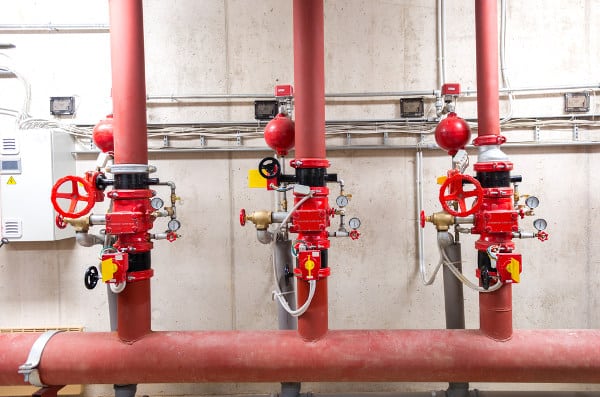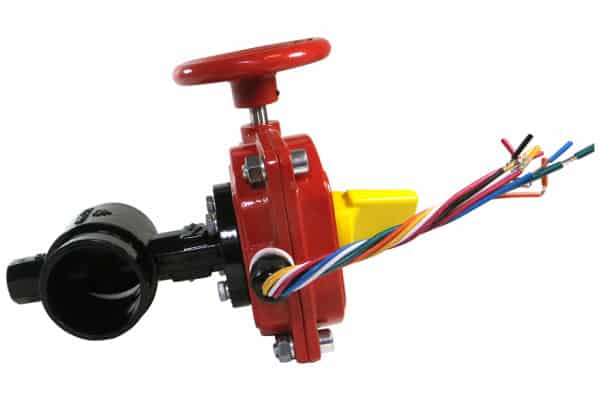Ease of installation and vibration resistance are the two key factors separating grooved butterfly valves and wafer butterfly valves
Butterfly control valves are installed as part of a fire sprinkler and standpipe system, streamlining the replacement of pipe downstream and controlling and visually indicating the flow of water during normal system operation. Wafer-type butterfly valves and grooved butterfly valves perform almost identically — but there can be big differences in terms of ease of installation, repair, replacement, and a few other aspects. In this article, QRFS explains the parts of a butterfly valve, the relevant couplings and piping systems, the National Fire Protection Association (NFPA) criteria, and the basic benefits and drawbacks of wafer and grooved valves.
All butterfly valves share the same basic anatomy
Butterfly valves are used in chemical production, petroleum processing and distribution, pharmaceutical manufacturing, and a wide range of commercial and industrial applications. Most butterfly valves provide precision flow control, install easily, and are lightweight compared with other valves.
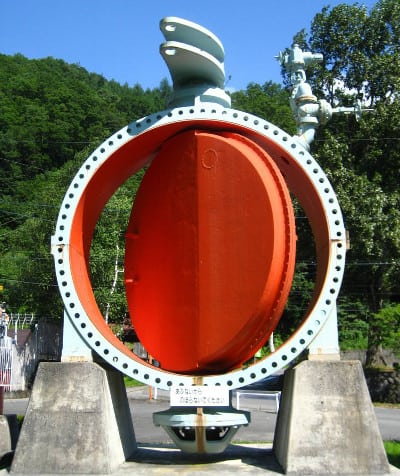
In fire sprinkler and standpipe systems, butterfly valves control water flow using a thin, rotating disc. The handwheel connects to a rod called a “stem,” which rotates the disc. This disc remains at least somewhat in the path of the water at all times, leading to a slight reduction in flow within the pipe even when fully open. The position indicator — usually a brightly colored part sticking out of the valve — turns with the disc to provide a clear indication of when the valve is opened or closed.
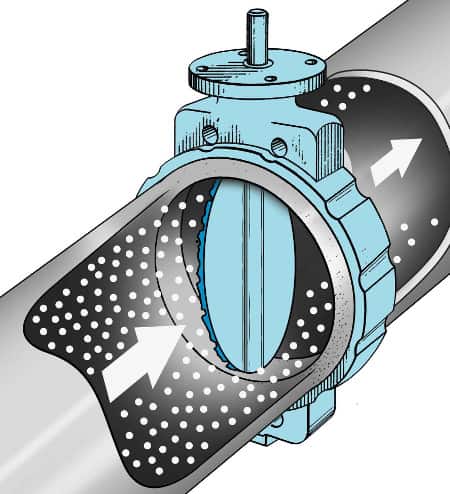
Butterfly valves for fire protection often include tamper switches that connect to a fire alarm control panel or another indicating device that sounds an alarm or otherwise warns when the valve’s status changes. Why?
Closed valves are the leading cause of sprinkler system failure. Fire sprinkler and standpipe systems should remain in service unless it’s absolutely necessary to shut them down, which means that a closed valve needs to become un-closed as soon as possible. Many butterfly valves feature one tamper switch for the control panel and another for auxiliary alarms and horns to provide ample notification of a closed valve.
The other main components of a butterfly valve are the body and the seat. The body houses the disc and other parts and is typically installed between two pipe flanges. The seat provides a liner between the disc and the body, ensuring an air- and/or water-tight seal when the valve is closed. In many models, the stem, disc, and seat are all exposed to the material flowing through the pipe and must be designed to withstand the appropriate temperature, pressure, and flow (and, in certain applications, the “media,” aka the liquid or semisolid material flowing through the pipe).
Wafer butterfly valves are slightly more economical, but grooved butterfly valves and couplings install quickly and offer several other benefits
The key difference between wafer and grooved butterfly valves is how they attach to a fire sprinkler or standpipe system pipe.
Most grooved butterfly valves for fire protection are roll-grooved. Roll grooving displaces part of the pipe wall, pushing a portion of the pipe in until a ring-shaped indentation forms. The grooved ends fit other grooved couplings, forming a leak-tight seal. These fittings make some repairs easier: if the pipe downstream of the grooved valve needs to be replaced, its downstream coupling can be removed and the valve closed, shutting off the supply of water. The valve stays in place. In contrast, a wafer valve needs to have both flanges on either side of it connected to each other to hold the valve in place.
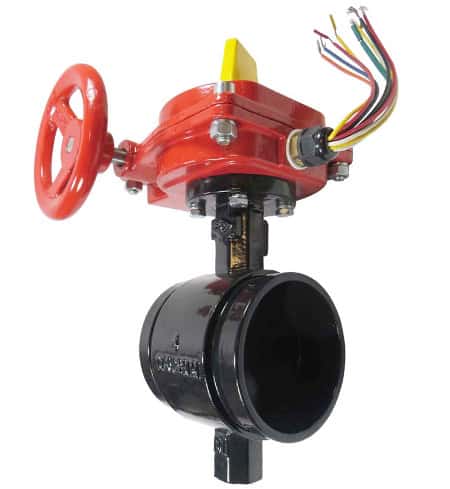
Grooved valves attach to piping with a listed and approved grooved pipe coupling and, when necessary, gasket lubricant. The grooved ends of the valve and the pipes are abutted, a gasket installed, and the remainder of the coupling is secured around the pipe. These couplings use only two bolts and are easier to tighten than other connections, making them as much as six times faster to install and significantly faster to remove when repairs are needed.
Grooved couplings offer a range of benefits in fire protection settings. Rigid grooved couplings act like welded joints, preventing pipe and fittings from rotating, flexing, or pulling apart. Flexible couplings provide protection from earthquakes and severe vibration. In many cases, they’re better than flanged systems at isolating and dampening vibration (and the leaks that come with it). The overall installation is also often smaller, making grooved valves better suited to installations in confined spaces.
In contrast, wafer butterfly valves have a smaller body and are generally less expensive than grooved-end butterfly valves. The key difference is that their installation requires pipe flanges — protruding connectors that weld, braze, or thread to existing pipes so that two pipes, or a pipe and some other fitting, can couple.
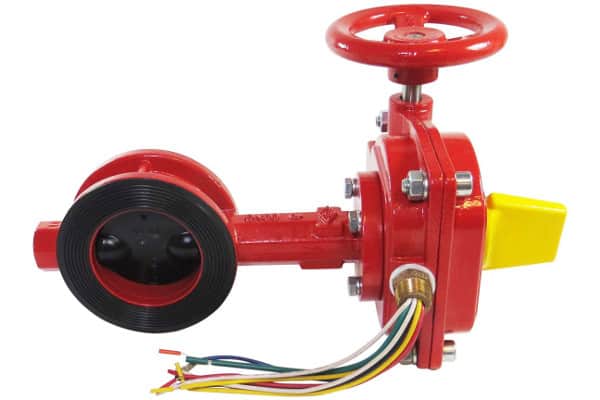
A typical wafer butterfly valve installation requires the use of these flanges along with the nuts and bolts needed to hold them together. This installation process is somewhat more involved. Flange thickness, flange diameter, and an appropriate bolt size and strength must be compatible with both piping and the valve. The disc and seat slide between the two flanges — which, if done carelessly, can damage seat material or the liner — and the flange bolts are tightened in a cross-draw sequence. Flanged joints can also be a source of leaks, and thus require regular retightening of bolts.
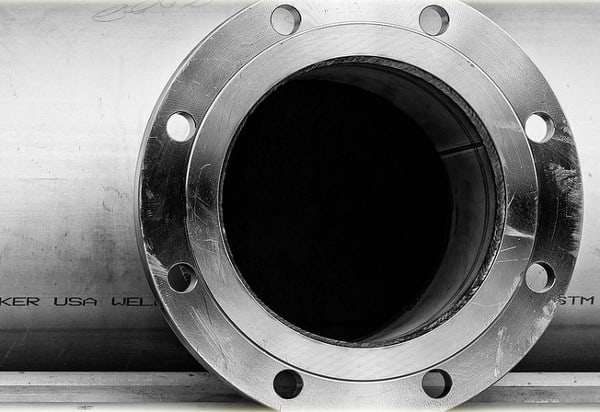
Wafer butterfly valves and grooved butterfly valves may install in NFPA fire sprinkler systems, standpipes, and fire pumps using compatible and approved fittings
A butterfly valve is used as a control valve in fire sprinkler and standpipe systems, permitting or preventing the flow of water to different areas within the network of pipes. These valves are especially useful when part of a system needs to be removed or replaced. Butterfly control valves are also used in conjunction with backflow-prevention devices on stationary fire pumps in systems that need additional water pressure and flow.
What guidance does the National Fire Protection Association (NFPA) provide for butterfly valve selection? First, all valves must meet certain criteria regarding approvals, pressure, and installation, and most control valves must be listed indicating valves (2022 NFPA 13: 16.9.3.2), meaning they physically display whether the valve is open or closed. NFPA also specifies one wrinkle regarding the installation of wafer valves:
From the 2022 edition of NFPA 13
16.9.2 Wafer-Type Valves. Wafer-type valves with components that extend beyond the valve body shall be installed in a manner that does not interfere with the operation of any system components.
The NFPA 13 Handbook provides additional commentary: “Documented instances of such discs contacting other system components and partially obstructing the waterway exist. To avoid contact with other components in close proximity of the butterfly valve, the valves should be installed with piping before and after the valve to provide the required clearance.”
Do these guidelines indicate when a butterfly valve, or a valve of any kind, should have one type of joining or another?
In short: no. Section 6.5 of NFPA 13 addresses grooved valves. These valves and couplings need to be compatible with each other and listed, but there’s no requirement — or preference — for one type of fitting over another (grooved or wafer).
From the 2022 edition of NFPA 13
6.3.5.1 Pipe, fittings, valves, and devices to be joined with grooved couplings shall contain cut, rolled, or cast grooves that are dimensionally compatible with the couplings.
6.2.5.2 Pipe, fittings, and appurtenances that are connected with grooved couplings and are part of a listed assembly shall be permitted to be used.
6.3.5.3* Pipe joined with grooved fittings shall be joined by a listed combination of fittings, gaskets, and grooves.
NFPA 13 clarifies that couplings “used to join grooved end pipe, fittings, or valves need to be installed using the preparation methods, groove types, and groove dimensions specified in the coupling manufacturer’s installation instructions.” Also: “Not all couplings or gaskets are intended to be used in dry systems. Therefore, only those couplings or gaskets investigated to achieve a proper seal and listed for the application should be used in dry pipe, preaction, and deluge systems.”
NFPA’s Standard for the Installation of Standpipe and Hose Systems (NFPA 14) and Standard for the Installation of Stationary Pumps for Fire Protection (NFPA 20) offer similar guidance: whether they’re installed as part of a grooved or a flanged piping system, butterfly valves simply need to be listed, approved, compatible, and properly installed according to standards and manufacturer instructions.
Listed and approved butterfly valves, couplings, and supervisory switches
If you’re installing or replacing a butterfly valve for fire protection, take a look at our selection of grooved butterfly valves and wafer butterfly valves in a range of sizes. Each valve is UL-listed and FM-approved for fire service and rated for pressures up to 300 PSI. We also carry everything needed to connect grooved pipes, including adapters, reducers, caps, couplings, tees, and more, plus joint-lubricating coupling grease.
QRFS valves ship with built-in supervisory switches for connection to both fire alarm panels and auxiliary notification devices. We also carry combination butterfly valve supervisory switches manufactured by Safe Signal. These switches work with butterfly valves of any size and mount to the valve housing through a 0.5″ NPT opening.
More questions? Get in touch with us at support@QRFS.com, through our contact form, or by giving us a call at 888.361.6662!
This blog was originally posted at blog.qrfs.com. If this article helped you, check us out at Facebook.com/QuickResponseFireSupply or on Twitter @QuickResponseFS.


